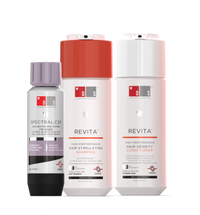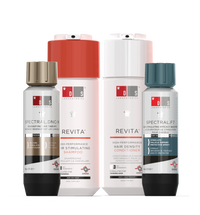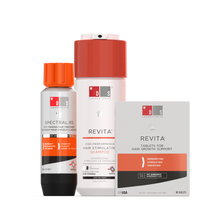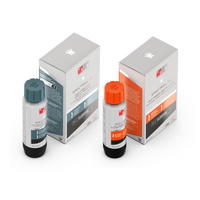If you have started to experience thinning hair or baldness as you get older, it may be androgenetic alopecia (male and female pattern hair loss). This common type of hair loss can be very frustrating to deal with. However, there are solutions that can help. Azelaic acid is one such potent substance for taking on androgenetic alopecia.
Does Azelaic Acid Block DHT & Cause Hair Growth?
Translation missing: en.blogs.article.author_on_date_html
What Is Azelaic Acid?
Azelaic acid is an organic compound in the dicarboxylic acid family. It is naturally occurring and found on skin, whole grains, rye, barley, animal products and other such sources.
For humans, azelaic acid helps to fight infections and functions as an antibacterial, antioxidant, pore-blockage fighter, skin blemish treatment and anti-inflammatory. In other words, we get a lot of benefits from azelaic acid.
The benefits have led to azelaic acid being recognized for its ability to decrease unwanted protein synthesis and control sebaceous gland activity. It is commonly used to treat acne and rosacea, two inflammatory skin conditions.
Many of these same properties make it an effective treatment for hair loss. In particular, it is known for blocking DHT.
What Is DHT?
Dihydrotestosterone is an androgen (male hormone) that is five times more potent than testosterone. It is an important hormone that helps develop male sex characteristics (all the physical characteristics that are typical of men). This includes the development of chest, back and facial hair.
Unfortunately, DHT can also be harmful to the growth of hair on the scalp. Your hair follicles go through these stages in a cycle: anagen, catagen and telogen. During the anagen phase, your hair is growing. The catagen phase is transitional and allows your follicle to renew itself. The telogen phase is a resting period.
DHT causes hair follicles to shrink and spend more time in the telogen phase, shortening the anagen phase. In other words, your hair grows less. Ultimately, the hair follicles will stop producing enough hair to erupt through the scalp.
While DHT is very important for men, especially during development and puberty, too much can cause the unwanted side effect of hair loss. Therefore, many hair treatments focus on blocking DHT in the scalp.
The Effect of Azelaic Acid on DHT
DHT is produced by an enzyme called 5-alpha-reductase which converts free testosterone to DHT. Azelaic acid helps to block DHT by inhibiting this enzyme. This process works by causing the 5-alpha-reductase to “swallow” the azelaic acid instead of free testosterone.
There are some other substances that work similarly such as finasteride. However, many of these are not naturally occurring and have more frequent side effects. Conversely, azelaic acid has only been observed to cause side effects in less than 1% of users. Furthermore, these are relatively mild irritation of the application side.
Azelaic acid has some of the best-established properties as a DHT blocker. Several studies have shown that it can be effective at helping to stimulate hair growth. It also has a high bioavailability and superior toxicological profile compared to other popular treatments.
Azelaic Acid and Hair Growth
The primary mechanism used by azelaic acid to promote hair growth is its 5-alpha-reductase inhibition properties. However, it appears to be even more effective than simply blocking DHT. As an antibacterial, antioxidant and anti-inflammatory substance, azelaic acid can combat many of the other contributing factors for hair loss.
Furthermore, recent research suggests that it can help with alopecia areata, a genetic form of hair loss. Alopecia areata has different mechanisms for causing baldness and is even more challenging to treat than androgenetic alopecia. This suggests that azelaic acid is a comprehensive hair loss treatment beyond its established DHT-blocking properties.
While azelaic acid is most effective when used with other ingredients that also promote hair growth, it can be helpful alone. Controlled studies have resulted in reduced hair loss and increased growth in patients using this substance.
Products That Contain Azelaic Acid
Spectral.DNC-N is a topical hair loss treatment created by DS Laboratories that contains azelaic acid among other ingredients. This treatment is clinically proven to help both men and women deal with androgenetic alopecia (as well as other forms of hair loss). In addition to azelaic acid, these are some of the ingredients in this powerful treatment:
-
Nanoxidil: This vasodilator helps open up ion channels in the scalp to bring nutrients and oxygen to hair follicles. It has a similar mechanism to minoxidil (Rogaine). However, it has a lower molecular weight and no known side effects. Nanoxidil can help prolong the anagen phase while azelaic acid protects hair follicles from DHT.
-
Copper Peptides: This anti-inflammatory agent protects your hair follicles from oxidative damage. It also helps to encourage remodeling of tissue. This has been clinically shown to stimulate hair growth, increase the size of follicles and fight hair loss.
-
Adenosine: This substance also has anti-inflammatory properties. It helps regulate the expression of growth factors in the skin’s papilla cells. It is also clinically proven to be effective at promoting hair growth.
- Caffeine: This ingredient isn’t just good for your coffee. It helps to reverse the effects of DHT. It also improves blood circulation in the scalp and extends the anagen phase.
Myristoyl pentapeptide-17, lysophosphatidic acid, retinol and lecithin are also included in the Spectral.DNC-N formulation. Together, these ingredients slow hair loss and improve the growth of new strong and healthy hairs.

















